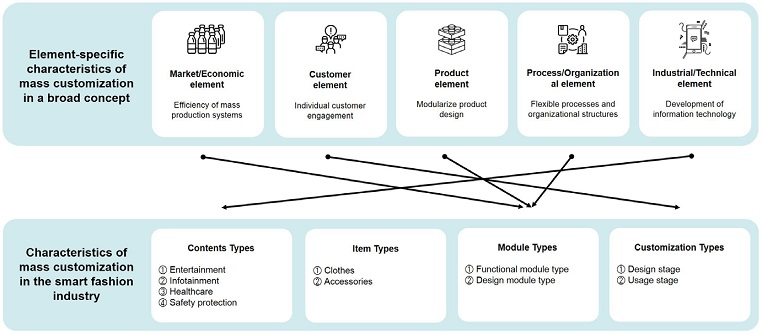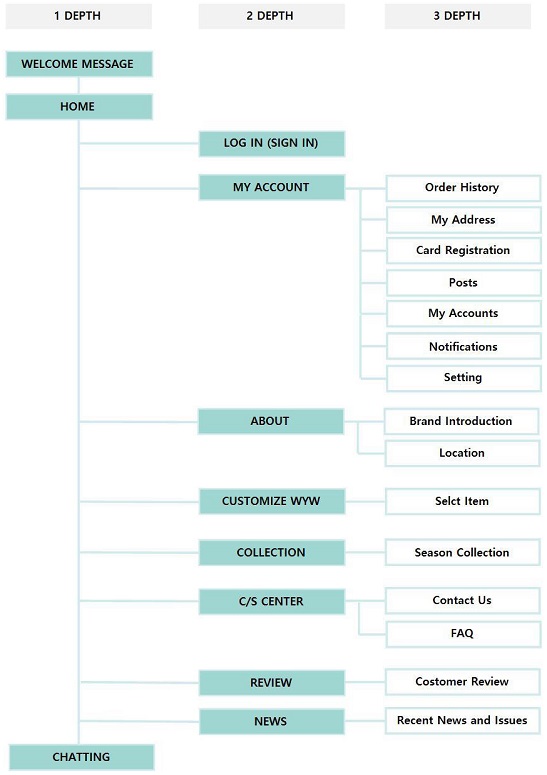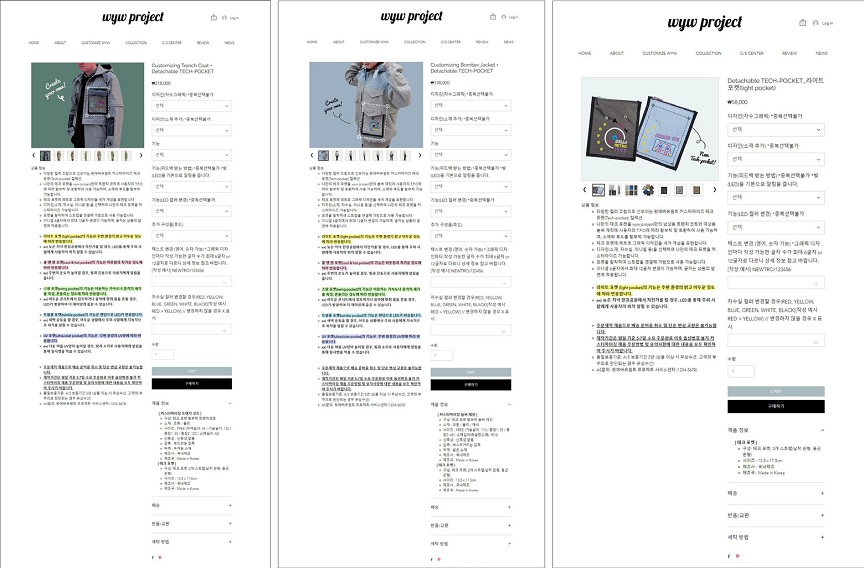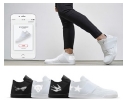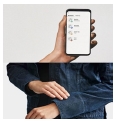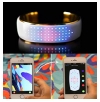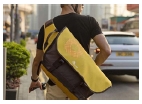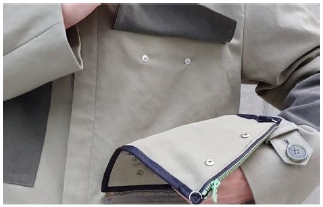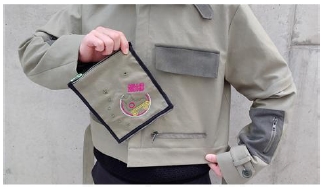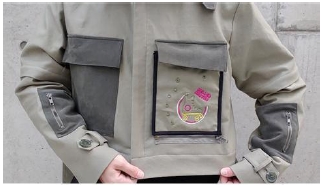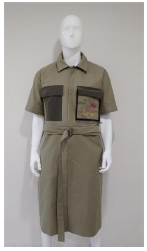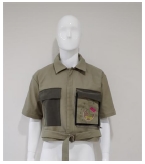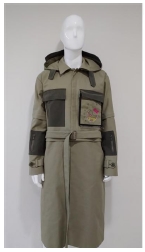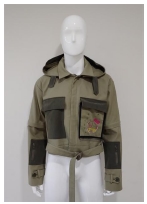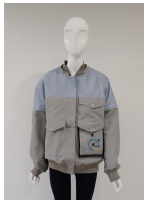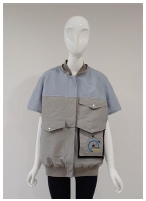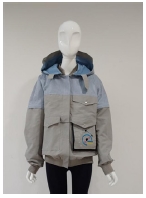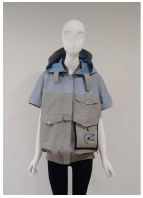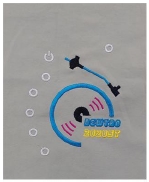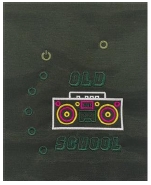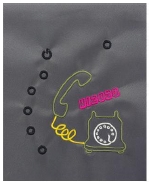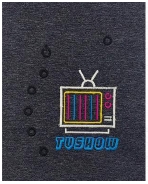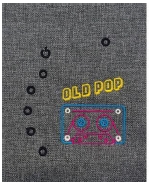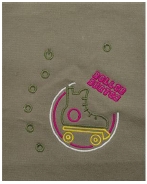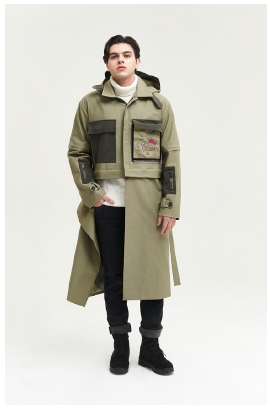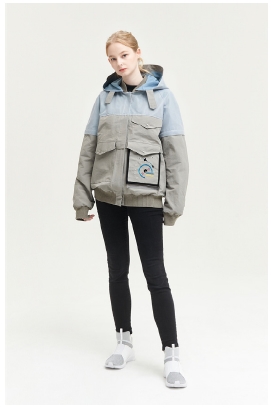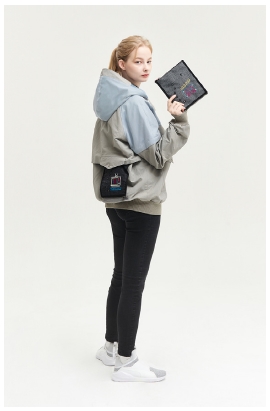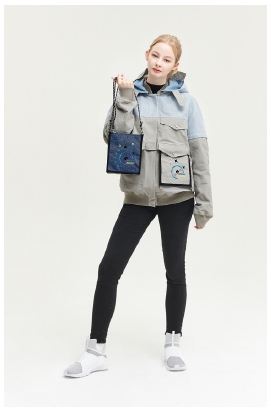
Development of Mass Customization Tech-pocket Smart Fashion Using Computer Embroidery Machine: Website Development Reflecting the Characteristics of Generation MZ
Abstract
Background Mass customization reflectings various individual customization trends has been recently spreading in the fashion industry due to the influence of Generation MZ. The wearable technology-based smart fashion industry is also pushing forward product development with various content items of customization. Therefore, the purpose of this study is to develop products that reflect the characteristics of mass customization and of Generation MZ in the smart fashion industry and to build a website to purchase these products.
Methods First, this study considered five factor-specific characteristics of mass customization in a broad sense and the main consumption characteristics of Generation MZ, and derived strategic directions and guidelines for mass customization applicable to the smart fashion industry. Second, tech pocket smart fashion products were developed with embedding fabric electronic technology based on a computer embroidery machine, and the website was built to select functional and design options with Wix, a CMS platform.
Results Two types of tech pocket smart fashion product were developed including a customized men’s trench coat and a customized women’s bomber jacket based on the entertainment content for Generation MZ. The website also allowed users to choose functional and design options according to their tastes.
Conclusions This study explored the developmental directions of customization tech pocket smart fashion products reflecting the characteristics of mass customization and the Generation MZ, and a website that could purchase products. This is meaningful in that the study suggests the possibility of developing a new business model in the smart fashion industry.
Keywords:
Mass Customization, Generation MZ, Smart Fashion, Website, Fabric Electronics1. Introduction
In 2020, Generation MZ including Millennials and Generation Z emerged as a major axis of consumption. In recent years, the fashion industry has witnessed the circulation of various standard product services in customized forms for individual clients such as D.I.Y. and customization that ask consumers to make for themselves before use. Online and mobile platforms for mass customization in which consumers can take part themselves are expected to make huge growth as major trends in the fashion industry. In the smart fashion industry with possibilities of new business based on the addition of wearable technology to the old fashion industry, there is a need for research on the development of mass customization fashion products reflecting the consumption characteristics of Generation MZ accustomed to the digital environment and new technologies and the establishment of a website where such products are available. The purposes of the present study are to develop smart fashion products reflecting the characteristics of mass customization in a broad sense and those of Generation MZ and build a website environment where consumers can participate in the design process themselves and make a purchase. Research methods and content covered the followings: 1) the characteristics of mass customization were identified according to its five elements in a broad sense, and its strategic directions guidelines were examined applicable to the smart fashion industry through case analysis; 2) the main consumption characteristics of Generation MZ were examined to figure out a strategy of developing mass customization-based smart fashion product; 3) a mass customization tech pocket smart fashion product was developed with built-in fabric electronics technology based on a computer embroidery machine. Among the various product categories, these products were selected as outer products that do not directly touch the user's skin in real life, so they can be used comfortably without any sense of difference and are less exposed to various external forces such as friction or wrinkles. In addition, for the development of a modular mass customization tech pocket, outer clothing suitable for function and design was selected as an item; and 4) a website was built with function and design options based on Wix, a CMS platform.
2. Literature Review
2. 1. A Study on the Definition and Characteristics of Mass Customization
In the dictionary, mass customization is defined as a compound word of mass production and one-on-one customization(Byun, 2003). It is a concept of large-scale customization, including the significance of customization for a large group and the public as well as mass production. In 1987, Stanley Davis first used the term, mass customization, in his ⎾Future Perfect⏌ to refer to products customized for the needs of individual clients. In his ⎾Mass Customization(1993)⏌, Joseph Pine mentioned mass customization as a paradigm shift in the old management practice, thus exposing the term to the general public. Since then, many different studies and literature works have defined mass customization as a combination of mass production and customization for their respective advantages. In mass customization, individual custom products and services that meet the increasingly fragmented and diverse needs of individual customers can be offered at a low cost through the efficiency of mass production that led the industrial age(Davis, 1987; Kotler, 1989; Pine, 1993; Pine, Victor & Boynton, 1993; Pine, Peppers & Rogers, 1995; Hart, 1995; Feitzinger & Lee, 1997; Gilmore & Pine, 1997; Duray, Ward, Milligan & Berry, 2000; Tu, Vonderembse & Ragu-Nathan, 2001; Wind & Rangaswamy, 2001; Byun, 2002; Jang, 2007). Individual customization varies in the degree of customization according to the stage in which customers participate across the manufacturing process(Lampel & Mintzberg, 1996; Addis & Holbrook, 2001; Kim & Cha, 2008) as well as the characteristics of individual customers(Spira, 1993). The development of production and manufacturing techniques, information technology(Silveira, Borenstein & Fogliatto, 2001; Yassine, Kim, Roemer & Holweg, 2004), and e-commerce has made it possible to provide mass customization at a reasonable price(Lee & Kim, 2001; Broekhuizen & Alsem, 2002; Tseng, Wang & Jiao, 2017). The definitions and characteristics of mass customization according to its elements were analyzed in previous studies. The analysis results identified five characteristics including efficiency of the mass production system as a market and economy element, participation of individual customers as a customer element, modularization of product designs as a product element, flexible process and organizational structure as a process and organization element, and development of information technologies as an industrial and technological element.
2. 2. Mass Customization Smart Fashion
Customizing smart fashion is based on the utilization of big data and information technologies. It refers to setting or changing hardware and software functions as well as instructions according to users’ needs or reorganizing them according to individual time, place, and occasion(TPO) in a broad sense for users’ easy use and convenient maintenance(Lee, Tak & Han, 2017).
As customized services have become a trend in the traditional fashion industry, the scope of research is expanding to marketing research (Jang, 2013), public consumer participatory design research (Park, 2014), and various online service platform research (Yang & Lee, 2017; Lee & Chung, 2020). However, current studies lack prior studies on the case of mass customization smart fashion that considers consumer needs. According to the need for research, examples of mass customization smart fashion products that consider consumer needs among smart fashion products were analyzed and presented. Customization smart fashion products are differentiated from common fashion products for their user-centered nature to take into consideration functionality and aesthetics based on wearable technology. After examining their characteristics in functions and aesthetics, the investigator traced the trends of mass customization in the smart fashion industry and analyzed cases in the four aspects of content, item, module, and customization types<Table 1>.
First, such products were divided into entertainment(25%, 4), infotainment(50%, 8), healthcare(19%, 3), and safety protection(6%, 1) according to the content types of their main functions. The characteristics of entertainment content-type products as a playful element can be changed to the desired text or form by changing LED colors and patterns in conjunction with mobile applications. It can also experience an animation effect that responds to music or external sounds and vibrations designated by the product user. A representative example of this is Pix's “Pix backpack”, in which the front LED display of the bag can be changed to suit the customer's needs. The characteristics of infotainment content-type products control major functions of smartphone applications, provide various schedules and information notifications, and analyze users' lifestyles and provide information. As for the design characteristics, the user can change the watch face design or detached/attached the module-type strap. A representative example of this is Jacquard X Levi's “Commuter trucker jacket” which can receive notifications about various information from linked applications. The characteristic of healthcare content-type products is that it collects, analyzes, and notifies users of big data based on a transmitter made in tag form. Each tag has the advantage of being detachable and compatible with various items. As a representative example, SKT X Misfit's “Health on Shine” can be detached and attached to a single device and used in the form of various watches, necklaces, bracelets, and tags that users want. The characteristic of safety protection content-type products is similar to entertainment types in that it changes LED colors and patterns, but as in the case of Roadwarez's “Smart cycling backpack”, it has specialized features for biker safety protection, such as accident detection technology, emergency user location notification, cycling path recording, etc. By producing each of these features in the form of a built-in standard product, it is linked to operating as a mass production approach for efficiency in market and economic factors. In addition, unlike general fashion industry, various functions based on wearable technology are built into the product itself, which itself links the development of information technology in industrial and technological factors. Second, they were divided into clothes(3 T-shirts, 1 jacket, 1 dress) and accessories(including 3 bags, 2 shoes, 3 watches, 3 jewelry) according to the item types. Third, they were divided into functional and design modules according to the module types. While functional modules refer to partial modules of products with built-in functions, design modules are partial modules based on design elements of smart products. In this regard, Blocks' “Modular smart watch” can be deformed by detached and attached functional modules with various types of sensors depending on user needs, and each module has a different design. This is connected to the modularization of product design in the product elements of mass customization in that modular products with built-in functionality and modular design products can be detached and attached according to customer situations and needs. And fourth, such products were divided according to the design and use stage according to the characteristics of customization to reflect user needs. As an example of the design stage, Sygnal's “LED t-shirt” is customized by users participating in the design phase by themselves through option settings. Examples of use stage include changing LED color or modifying a module-type design. This is linked to the involvement of individual customers in the previously derived customer component of mass customization in that the various tastes and needs of the customer can be directly reflected in the product during the design and use stage of the product.
Mass customization had the following guidelines and strategic directions in the connected smart fashion industry according to its characteristics by the five elements analyzed above: First, importance was placed on the efficiency of the mass production system as a market and economy element in a broad sense along with a flexible process and organizational structure as a process and organization element. A standard product would be made with built-in functions for the parts manufactured in advance or in modular designs for each form, being connected to the modular forms in the smart fashion industry. The present accepted smart fashion products as an “instrumental” concept capable of production based on the mass production system and flexible process in order to carry out mass customization and set a goal of finding a tool fit for the making of a smart fashion product.
Second, the participation of individual customers emphasized as a customer element allows consumers to reflect their needs in product service through option choices. This reflects customer needs through their participation at the design and use stage, being connected to the customization types in the smart fashion industry. In the present study, customization methods through the participation of individual customers were developed at the design and use stage. At the design stage, customers are allowed to choose options themselves according to their needs at a smart fashion website. At the use stage, they can alter or revise the smart products designed at the previous stage according to their diverse situations and tastes. This means that users can choose between function and design options of smart products within a website in the aspect of functions. In the aspect of designs, this means customized products that customers can alter and revise themselves.
Third, the modularization of product designs emphasized as a product element means partial parts or additional components of products are made in modular forms. Modular products with built-in functionality or modularized design products can be made detachable according to the situations and needs of individual customers, which is connected to the modular form types in the smart fashion industry. In the present study, products were designed that would be detachable to various platforms in modular forms in the design aspect.
And fourth, the development of information technologies and e-business emphasized as an industrial and technological element was connected to the content types in the smart fashion industry based on information and wearable technologies. In the present study, a website was built which targeted the online mass customization market based on the utilization of wearable technology in the smart industry. <Figure 1> shows the guidelines of mass customization smart fashion products.
2. 3. Analysis of Characteristics of Generation MZ
In the present study, a generation is defined in a cohort generation concept that is applied most universally to refer to a group of people that are born in similar time, share the same historical and cultural experiences, and have similar lifestyles and attitudes based on these experiences(Jung, 2018). In other words, consumers in fragmented generational groups have similar lifestyles and consumption tendencies(Yin, 2019). In South Korea, generations are categorized into the Baby Boom, X, Millennials(Y) and Generation Z. Born in 1980~1994 following the Generation X, Millennials experienced internationalization and informatization during their growth(Kim & Huh, 2007, Ye & Chin, 2009). Born since 1995, Generation Z are called digital natives that are exposed to advanced digital technologies during childhood(Park, 2016; Oh, 2018) and are sensitive to fast changes and new technologies(Choi, 2015; Park, 2016). Similar to the Millennials, they prefer their own individuality and exhibit individualistic tendencies. In the viewpoint of the old cohort, Generation MZ that experienced digital technologies during growth or childhood following the appearance of the Internet and portable electronic devices in the 1980s was born and grew up in a digital environment and called a digital generation to consume media around the Internet and mobile environment. The Millennials and Generation Z are collectively called Generation MZ in that they show similar characteristics while being different with vague criteria to distinguish them.
Generation MZ has emerged with greater importance than any other generations because they have become active economically and begun to exert the biggest economic influence(Choi, 2020). Companies home and abroad expand design options or make individual custom products based on IT by examining the tendencies and consumption trends of Generation MZ. Furthermore, they launch products in whose making process consumers take part, offering custom products and services targeting Generation MZ. The present study proposed the following approaches to mass customization according to the five consumption characteristics of Generation MZ analyzed in previous studies on the generation:
First, Generation MZ is accustomed to the Internet and mobile environment as a digital generation and is active with activities of consuming IT-applied products such as smartphones. Smart fashion products with built-in functions should be developed for Generation MZ accustomed to various IT environments and products along with a website that provides them with experiences in the online shopping mall form; second, Generation MZ wants to express their individualistic identifies, which raises a need to develop products with function and design option settings based on diverse combinations of trendy colors and materials to satisfy their individual tastes and individualities; third, Generation MZ seeks after experiential consumption, which raises a need to develop mass customization products and websites to induce their active participation as prosumers along with special experiences; fourth, it is analyzed that Generation MZ will have great preference for smart fashion products developed around entertainment content to receive instant feedback as they are in pursuit of instant amusement; and fifth, Generation MZ seeks after cost-effectiveness for their pursuit of balanced consumption, thus having high preference for mass customization products with the efficiency of mass production. In the present study, a website was built in the online environment for mass customization targeting Generation MZ that generated economic effects as a major axis of consumption in 2020 in accordance with the growing trend of mass customization.
2. 4. Strategic Direction of Using Computer Embroidery Machine
Fabric electronics is a compound of fabric and electronics(Lee & Kim, 2020), referring to electronic fabric. In its early days, it was defined as a fabric with added electric characteristic while keeping its original characteristics as simple fabric. In recent studies, however, it is understood in a broader sense as an intelligent and functional fabric that reacts to an external environment or stimulus, plays the roles of delivering, producing, and saving signals with fabric itself, and is capable of interactive interactions as well as networking(Park & Kim, 2013). When fabric electronics is worn on the body or connected to clothes during an activity, users should be able to feel comfortable with no sense of difference, which means that fabric electronics should be design in a flexible way through microminiaturization and super light-weight. With built-in electric functions in fabrics, it should be durable against frictions of various movements and environmental conditions of external force such as expansion and contraction, crumpling, and alteration as users wear or use it(Jung, 2016). There are two ways to make fabric electronics; one is fabric, knitwear, and embroidery based on conductive yarns, and the other is printing based on conductive materials. In the embroidery form, embroidery is made on various knitwear and fabrics with a computer embroidery machine, which leads to light and flexible merits thanks to the thin layer structure. It is relatively easy to make diverse precision electronic circuits, and process automation makes it possible to produce the same electronic circuit repeatedly, which makes the form applicable to mass production. A variety of fabric sensors are being developed along with the electronic parts of LilyPad Arduino and Adafruit that can be connected to various knitwear and fabrics with conductive yarns instead of old parts that had to be connected with wires for the sake of flexible human-friendly design needed for fabric electronics in the smart fashion area. These developments raise a need for research on fabric electronics in the embroidery form based on a computer embroidery machine and conductive yarns. The present study embodied the fabric electronics technology with a computer embroidery machine capable of process automation and mass production. Strategic directions are proposed based on a computer embroidery machine: first, a human-friendly fabric electronic smart product would be made in a thin and flexible layer structure with embroidery directly on fabrics; second, diverse precision circuits of fabric electronics would be designed and made with a design program connected to a computer embroidery machine; third, a reliable product would be made with the electronic parts of LilyPad Arduino and Adafruit; fourth, programmed circuits would be embroidered with a computer embroidery machine capable of mass production through the process automation of the same circuits; and fifth, such a product would be applied to items after it receives various design patterns through a design program connected to a computer embroidery machine and uses embroidery yarns of various colors to generate the graphic effects unique to embroidery.
3. Results
3. 1. Functional Aspect
In the study, the investigator realized customization for customers by allowing Generation MZ, who is accustomed to the digital environment with a pursuit of their own individuality and experiential consumption characteristics, to participate in the manufacturing process. User scenarios were also designed to make smart fashion products based on mass customization as a concept of large-scale customization through the efficiency of the mass production system. As Generation MZ has preference for playful fun, sensors were attached which would interact with each external environment around entertainment content. Five sensors were selected including illumination, temperature, acceleration, twinkle, and UV sensors for compatibility among modules in the design of a circuit diagram to ensure the flexible process of fast reactions. <Table 2> shows user scenarios and system designs for each sensor.
System designs were divided into hardware and software designs. In a hardware design, fabric electronics technology was designed and embodied with a computer embroidery machine and conductive yarns. According to the information provided by Arduino LilyPad, the laundry reliability of Arduino LilyPad recommends hand-washing with a mild detergent and drip-dry after disconnecting the power supply. The main board of Arduino LilyPad, which was designed to be compact and light with laundry reliability, was used. Sensor modules were connected to this including five sensor modules reacting to surrounding environments, feedback notification sensor modules, and coin cell battery modules that users can replace themselves for light wearability and usability. Five sensors were attached to react to external environments including illumination, temperature, acceleration, UV, and twinkle sensors. The consumption characteristics of Generation MZ in pursuit of fun were applied in the aspect of entertainment content through Visual Writing, and feedback for each sensor was organized based on light(LED). Additional options were set including vibration(vibration sensors) for users that would want tactile feedback and sound(piezo sensors) for users that would want auditory feedback. Five different LED colors including white, red, yellow, green, and blue were introduced to give visual notification feedback in reaction to each environment. A battery holder with an on/off switch was designed according to the needs of users that would want each function or no functions. A circuit diagram was designed with the fabric electronics technology based on a computer embroidery machine capable of mass production to offer customization in the efficiency of the mass production system. The size of a circuit diagram was designed with the minimum path of action on mind so that users would not have inconvenience with wearing the product with the design elements of the tech pocket undisturbed. The same LED arrays and module positions were designed and developed to allow five sensors to change easily without any restrictions according to designs and functions in the mass customization form through computer embroidery machine programming for the efficiency of mass production. In software design, twinkle sensors with built-in MCU were excluded for random LED luminescence. The remaining four sensors were programmed in a way that LED, vibration and piezo sensors would react to each designated sensor value according to the factors of an external environment based on the Arduino IDE(integrated development environment) of the LilyPad Arduino 328 main board.
(1) WYW PROJECT Website Based on Wix
A website was built with Wix, a CMS platform, which would offer a range of function and design options for mass customization tech pocket smart fashion products. Wix was selected for the study as it was a platform for many micro-enterprises compared with the old HTML environment with the saving of initial costs and time based on easy revision and change thanks to more than 500 free template designs and intuitive interface in the drag-and-drop method. The present study developed a website for mass customization tech pocket smart fashion products based on Wix, and it was called “WYW Project”(Whatever You Want Project) (https://wywproject.wixsite.com/home). <Figure 2> shows the menu tree according to the 1 depth, 2 depth, 3 depth of the website. The main screen of the WYW Project website was comprised only of main menus with a navigation bar designed in a horizontal collinear form. The global navigation menus included “Home,” the main menu, “About,” which introduces the brand, “CUSTOMIZE WYW,” which offers a variety of function and design option choices, “COLLECTION,” which offers product pictures and videos in each season, “C/S CENTER,” which is a customer service center menu for customer inquiries and FAQs, “REVIEW,” which allows customers to post the pictures or videos of their customized products freely, and “NEWS,” which provides the latest news and issues of the brand.
(2) Functional/Design Option Selection
Of the two customization approaches through the participation of individual customers emphasized as a customer element, the design stage makes it possible to make individualistic tech pocket smart fashion products based on the diverse combinations of function and design options according to the tastes and needs of individual customers at the WYW Project website. It was designed to allow users to select and purchase a product option under the Customize WYW menu on the global navigation menu. Each product and service was designed to reflect the consumption characteristics of Generation MZ around each function and design option including a men’s trench coat and women’s bomber jacket with a tech pocket of entertainment content and detachable tech pocket. Based on sensor modules needed to make fabric electronics, a tech pocket was comprised of sensors reacting to an external environment, visual, tactile, and auditory notification feedback methods, and LED color changes for function options. There were four design options including graphic embroidery designs in the newtro concept, addition of mesh and vinyl materials, color changes of embroidery yarns, and changes of texts in English numbers. Another design option, a hood, was added to the customized men’s trench coat and women’s bomber jacket<Figure 3>.
3. 2. Design Aspect
(1) Modular Design
The modular tech pockets are design elements for mass customization and can be compatible between men’s trench coat and women’s bomber jacket according to users’ tastes and situations. They were designed to ensure easy attachment to clothes and detachment from them with a snap at the back and an open zipper at the bottom. They were also designed to be detachable on their own so that there would be no sense of difference along the boundary of everyday clothes and functional ones. In addition, they were designed to serve as pockets attached to clothes and detachable bags as a carrying system. A detachable system in the same form was applied to the chest of men’s trench coat and the chest and back of women’s bomber jacket<Table 3>.
(2) Customization
Of the two customization approaches through the participation of individual customers emphasized as a customer element, the use stage makes customization possible according to users’ tastes and situations. The men’s trench coat was designed to enable the attachment and detachment of the bottom hem and sleeves, and the women’s bomber jacket was designed to enable the attachment and detachment of sleeves. At the website for mass customization smart fashion products, users were also allowed to choose a hood as a detachable additional option<Table 4>,<Table 5>.
(3) Visual Lighting
LED was used to express the individuality of Generation MZ through light and colors based on entertainment content. Given the characteristics of Generation MZ that yearned for attention from others through the expression of their individuality, LED-based Visual Writing increased attention on users further and enabled emotional interactions between users and non-users. Reacting to surrounding environments, sensors were designed to give feedback based on visual LED effects through random or sequential luminescence.
(4) Newtro Graphic Embroidery Design
Newtro graphic embroidery designs were made with ZSK’s multi-head computer embroidery machine. Newtro is a new coinage of “new” and “retro,” referring to the trend of enjoying retro anew among the new generation(Kim, Jeon & Kim, 2019). It is one of the biggest concept issues among Generation MZ, as well. Six graphic elements including “record, roller skate, radio, call, tape, and television” were selected fit for newtro from the old objects and items and designed and printed in graphic embroidery designs with ZSK’s computer embroidery program(EPCwin) <Table 6>.
4. Conclusions
In the present study, the investigator developed tech pocket smart fashion products reflecting the characteristics of mass customization and those of Generation MZ whose consumption influence had grown bigger and built a website where users were allowed to select and purchase function and design options.
First, the study analyzed mass customization in a broad sense in the smart fashion industry according to its characteristics by the element and its correlations by the type. This analysis by the type is significant to offer guidelines and strategic directions for the development of smart fashion products based on mass customization.
Second, this study was developed detachable tech pockets and customizable men’s trench coat and women’s bomber jacket as mass customization smart fashion products. A computer embroidery machine capable of mass production was used as a tool to develop tech pockets with built-in functions and embody the efficiency of the mass production system. Modular designs were created to design men’s and women’s clothes detachable and compatible with no distinction between them through an open zipper and snap. The men’s trench coat and women’s bomber jacket were designed to enable the customization of sleeves, hoods, and bottom hems and embody customization for individual customers.
Finally, a website was designed with Wix, a CMS platform, for Generation MZ accustomed to the digital environment. Three function options and five design options were offered for the smart fashion products of entertainment content at the website. Customization was embodied through the participation of individual customers in a process of selecting each function and design option themselves according to their needs for smart fashion products.
The present study explored the developmental directions of customized detachable tech pocket smart fashion products and a website by reflecting the characteristics of mass customization by the element and the consumption characteristics of Generation MZ and proposed developmental directionality as a new business model in the smart fashion industry, thus holding its significance. In this study, outerwear exclusively for men and women were proposed, but in the future, we need to develop various categories of items such as top, bottom, and accessories so that users can choose various items. In addition, this study also raises a need to propose more improved and advanced UI/UX by assessing the usability of a website with users and reviewing inconvenience and shortcomings in the use process and conduct research on the development of a new online business platform specialized for customization.
Acknowledgments
This work was supported by the National Research Foundation of Korea(NRF) Grant funded by the Korean Government (MSIP) [2015R1A5A7037615].
This thesis was written based on the first author's master's thesis.
Notes
Copyright : This is an Open Access article distributed under the terms of the Creative Commons Attribution Non-Commercial License (http://creativecommons.org/licenses/by-nc/3.0/), which permits unrestricted educational and non-commercial use, provided the original work is properly cited.
References
-
Addis, M., & Holbrook, M. B. (2001). On the conceptual link between mass customisation and experiential consumption: an explosion of subjectivity. Journal of Consumer Behaviour: An International Research Review, 1(1), 50-66.
[https://doi.org/10.1002/cb.53]

- Arduino. LilyPad Arduino Main Board. Retrieved from https://www.arduino.cc/en/Main/ArduinoBoardLilyPad/.
-
Broekhuizen, T. L. J., & Alsem, K. J. (2002). Success factors for mass customization: a conceptual model. Journal of Market-Focused Management, 5(4), 309-330.
[https://doi.org/10.1023/B:JMFM.0000008072.35988.ef]

- Byun, J. H. (2003). Customer participatory design for mass customization: Focused on development of interactive design toolkit. Archives of Design Research, 16(4), 5-14.
- Choi, G. E. (2020). A Study on the Renewal of Package Design for Mccol Brand Reactivation: Focused on Generation MZ Targets. Brand Design Association of Korea, 39-41.
- Choi, I. Y. (2015). A Study on the Objectives of Communication Design Education for the Generation Z. Journal of the Korean Society Design Culture, 21(3), 675-683.
- Davis, S. M. (1987). Future Perfect. MA: Addison Wesley.
-
Duray, R., Ward, P. T., Milligan, G. W., & Berry, W. L. (2000). Approaches to mass customization: configurations and empirical validation. Journal of operations management, 18(6), 605-625.
[https://doi.org/10.1016/S0272-6963(00)00043-7]

- Feitzinger, E., & Lee, H. L. (1997). Mass customization at Hewlett-Packard: the power of postponement. Harvard business review, 75, 116-123.
- Gilmore, J. H., & Pine, B. J. (1997). The four faces of mass customization. Harvard business review, 75(1), 91-102.
-
Hart, C. W. L. (1995). Mass customization: conceptual underpinnings, opportunities and limits. International Journal of Service Industry Management, 6(2), 36-45.
[https://doi.org/10.1108/09564239510084932]

- Jang, M. H. (2013). A Study of Mass Customization Marketing Strategies in Apparel Industry Linked to Development in Smart Media (Unpublished master's thesis). Honam University, Gwangju.
- Jang, S. K. (2007). Value Creation Strategy in Mass Customization Based on the e-business. The e-business studies, 8(4), 77-94.
- Jung, K. Y. (2018). The Relationship between the Millennial Generation and the Older Generation of S Group on Self-directed Learning Readiness and Job Satisfaction (Unpublished master's thesis). Korea University Graduate School of Education, Seoul.
- Jung, J. S. (2016). Development trends and prospects of wearable smart devices. Textile technology and industry, 20(2), 87-101.
-
Kim, K. C., & Cha, H. J. (2008). Types of Customization and It's Strategy. Journal of Product Research, 26(4), 153-166.
[https://doi.org/10.36345/kacst.2008.26.4.013]

- Kim, M. H., Jeon, H. M., & Kim, D. Y. (2019). Newtro Trend. Marketing, 53(2), 57-65.
-
Kim, W. S., & Huh, E. J. (2007). Comparing Consumption-Related Values and Lifestyles of Baby Boomers, Generation X, and Generation Y. Journal of Consumption Culture, 10(4), 31-53.
[https://doi.org/10.17053/jcc.2007.10.4.002]

-
Kotler, P. (1989). From mass marketing to mass customization. Planning Review, 17(5), 10-13.
[https://doi.org/10.1108/eb054267]

- Lampel, J., & Mintzberg, H. (1996). Customizing customization. Sloan management review, 38(1), 21-30.
-
Lee, M. S., & Jung, K. H. (2020). Building an E-commerce Based Platform for Mass Customizable Hanbok Design Development. Journal of the Korean Society of Costume, 70(4), 80-104.
[https://doi.org/10.7233/jksc.2020.70.4.080]

- Lee, W. J., & Kim, T. W. (2001). Mass customization from an e-business perspective. Journal of the Korean Production and Operations Management Society, 12(1), 109-130.
- Lee, E. K., & Kim, Y. H. (2020). A Study on the Development of Fabric Electronics' Customized Smart Bag Using Computer Embroidery. Journal of the Korea Convergence Society, 11(7), 105-112.
- Lee, Y. J., Tak, J. P., & Han, W. H. (2017). Customizing Marketing. Marketing, 51(12), 65-70.
- Oh, S. Y. (2018). Pay attention to Generation Z. Marketing, 52(1), 57-62.
- Park, C. R. (2014). The Study on Jewelry Design for Mass-Customization.- Based on Layered Rings (Unpublished master's thesis). Seoul National University of Science and Technology, Seoul.
- Park, S. K., & Kim, W. K. (2013). Electronic and smart textiles. Polymer Science and Technology, 24(1), 38-44.
-
Park, H. S. (2016). A Study on the Characteristics of New Generation with Life Style: Focus on Generation Z. Journal of Humanities and Social Sciences 21s, 7(6), 753-767.
[https://doi.org/10.22143/HSS21.7.6.44]

- Pine, B. J. (1993). Mass Customization: The New Frontier in Business Competition. Boston: Harvard business school press.
- Pine, B. J., Victor, B., & Boynton, A. C. (1993). Making mass customization work. Harvard business review, 71(5), 108-11.
-
Pine, B. J., Peppers, D., & Rogers, M. (1995). Do You Want to Keep Your Customers Forever?. The Journal of Product Innovation Management, 5(12), 446-447.
[https://doi.org/10.1016/0737-6782(96)82971-7]

-
Spira, J. S. (1993). Mass customization through training at Lutron Electronics. Planning Reviews, 21(4), 23-24.
[https://doi.org/10.1108/eb054423]

-
Silveria, G. J. C. D., Borenstein, D., & Fogliatto, F. S. (2001). Mass customization: Literature review and research directions. International journal of production economics, 72(1), 1-13.
[https://doi.org/10.1016/S0925-5273(00)00079-7]

-
Tseng, M. M., Wang, Yue., & Jiao, R. J. (2017). Mass Customization. BE: Springer.
[https://doi.org/10.1007/978-3-642-35950-7_16701-3]

-
Tu, Q., Vonderembse, M. A., & Ragu-Nathan, T. S. (2001). The impact of time-based manufacturing practices on mass customization and value to customer. Journal of Operations management, 19(2), 201-217.
[https://doi.org/10.1016/S0272-6963(00)00056-5]

- Wind, J., & Rangaswamy, A. (2001). Customerization: The Second Revolution In Mass Customization. Journal of Interactive Marketing, 15(1), 13-32.
- Yang, H. J., & Lee, J. R. (2017). A Study on the Analysis of Online Customizing Markets and the Directions of Services. The Treatise on The Plastic Media, 20(2), 110-119.
-
Yassine, A., Kim, K. C., Roemer, T., & Holweg, M. (2004). Investigating the role of IT in customized product design. Production Planning & Control, 15(4), 422-434.
[https://doi.org/10.1080/0953728042000238782]

- Ye, J. E., & Chin, H. (2009). A Interview and Empirical analysis on New Generation Workers' Characteristics. Korean Journal of Resources Development, 12(2), 67-86.
- Yin, X. L. (2019). A Study on the Consumers' Motivation for Consumption of Chinese Millennials and Intention to Buy Luxury Brands in Foreign Countries (Unpublished Doctoral dissertation). Chungnam National University Graduate School, Daejeon.

